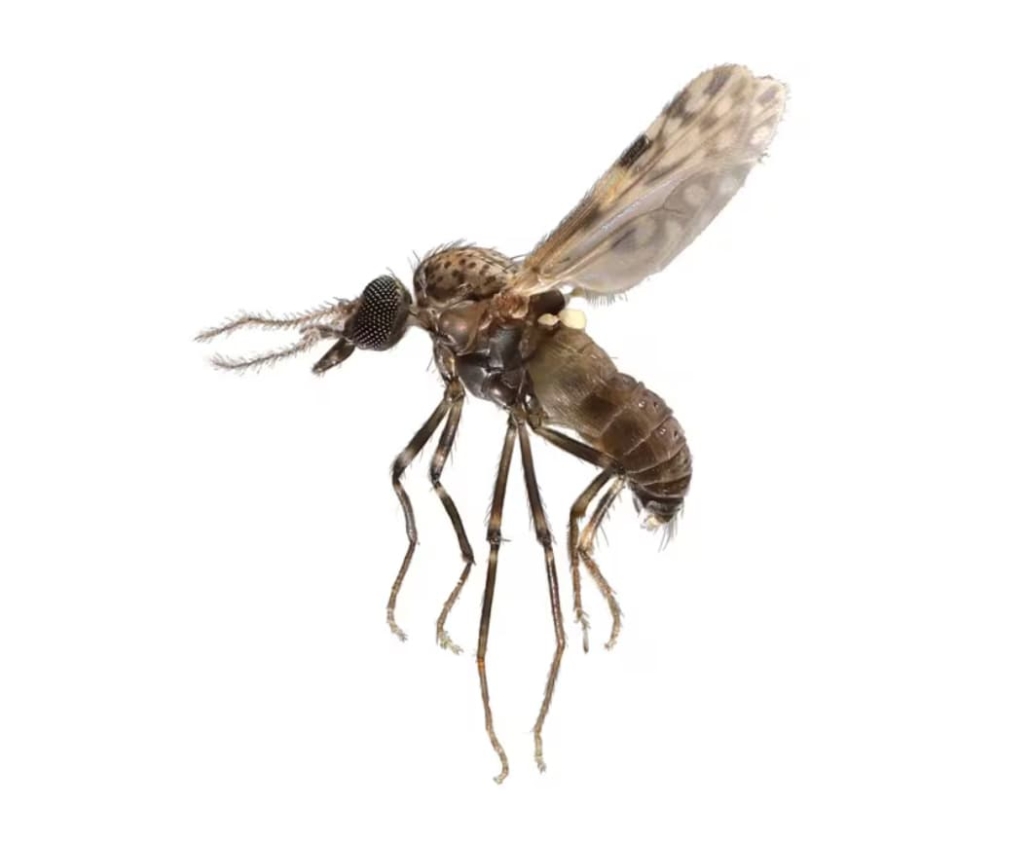First deaths recorded from Oropouche virus: PAHO calls for increased vigilance as virus spreads
Recent deaths and potential vertical transmission prompt heightened concern over the midge- and mosquito-borne disease, as cases surge across the Americas and first cases are reported in Europe.

Culicoides paraensis midge
The Pan American Health Organization (PAHO) has issued an urgent call for enhanced surveillance and diagnostic measures following a significant increase in Oropouche virus (OROV / Orthobunyavirus oropoucheense) cases across the Americas. The alert comes in response to the geographic spread of the disease, recent fatalities, and potential instances of mother-to-child transmission, marking a critical juncture in the understanding and management of this arboviral infection.
Unprecedented spread and severity
As of late July 2024, 8,078 confirmed cases of Oropouche fever have been reported in the region, including two deaths – the first ever attributed to the virus. The outbreak has affected five countries: Bolivia, Brazil, Colombia, Cuba, and Peru, with Brazil accounting for the vast majority of cases at 7,284. This surge represents a considerable expansion of the virus’s traditional range, which was historically confined to the Amazon region.
The geographic spread of OROV is attributed to various factors, including climate change, deforestation, and unplanned urbanisation. These environmental shifts have facilitated the virus’s movement into non-Amazonian states in Brazil and countries previously unaffected, such as Bolivia and Cuba.
In June and July 2024, 19 imported cases of Oropouche virus disease were reported for the first time in EU countries: Spain (12), Italy (5), and Germany (2). Eighteen of the cases had a travel history to Cuba and one to Brazil.
Transmission and clinical manifestations
Oropouche virus is mainly transmitted to humans as a result of being bitten by infected midges, however some mosquitoes species can also spread the virus. The principal vector (Culicoides paraensis midge) is widely distributed across the Americas, but absent in Europe. According to the European Centre for Disease Prevention and Control (ECDC) [1], there has been a lack of evidence as to whether European midges or mosquitoes could transmit the virus.
The ECDC says the likelihood of infection for EU/EEA citizens travelling to, or residing in epidemic areas in South and Central America is currently assessed as moderate. However, the ECDC recommends that due to the potentially high impact of congenital OROV infection, pregnant women planning to travel to epidemic countries where transmission is ongoing or has been reported should be provided with comprehensive information on the potential risk associated with OROV infection and prevention strategies.
Oropouche fever typically presents with sudden onset of fever, severe headache, joint and muscle pain, and in some cases, rash, photophobia, diplopia, and gastrointestinal symptoms. While most cases resolve within five to seven days, some patients may experience prolonged recovery periods of several weeks. The recent outbreak has brought attention to more severe manifestations, including rare cases of aseptic meningitis.
Of particular concern are the investigations in Brazil regarding potential vertical transmission from pregnant women to their foetuses. This development has raised alarms about the possible impact of OROV on foetal development, echoing concerns reminiscent of the Zika virus outbreak.
Diagnostic challenges and surveillance
OROV can be confirmed through molecular diagnosis, and PAHO has bolstered diagnostic capacity in 26 countries across the region. However, the similarity of OROV symptoms to other arboviral infections, coupled with a lack of systematic surveillance in many countries, suggests that current figures may underestimate the true prevalence of the disease.
Associate Professor Enny Paixao from the Centre for Epidemic Preparedness and Response at the London School of Hygiene & Tropical Medicine commented on the situation:
“There is much we still do not know about the Oropouche virus but one of the main concerns arising from the current outbreak is its potential harmful effects on unborn foetuses.”
She added, “The current outbreak does not yet show the same level of abnormalities in newborns as the Zika epidemic. However, the risks of Oropouche virus infection to foetal development remain uncertain and require closer scrutiny.”
Environmental factors and virus evolution
The recent surge in cases may be attributed to a combination of factors, including enhanced surveillance, environmental changes, and potential alterations in the virus itself. Climate change, in particular, is thought to play a significant role in the expansion of OROV, similar to its impact on other vector-borne diseases like dengue.
Professor Paixao commented on these factors: “Similarly to other vector-borne diseases such as dengue, climate change may also be impacting Oropouche virus expansion. Changes to temperature and precipitation can affect transmission, for example, rising temperatures can enhance the rate of development of Culicoides midges, one of the virus’ main transmission vectors alongside mosquitos.”
Recent research has also indicated that the predominant OROV strain circulating in 2023-2024 exhibits higher replication rates in mammalian cells compared to older strains, potentially contributing to increased transmissibility.
Prevention and management
In the absence of vaccines or specific antiviral treatments for Oropouche fever, management remains symptomatic, focusing on pain relief and rehydration. PAHO recommends that individuals take preventive measures, including the use of repellents, protective clothing, and fine-mesh mosquito nets, particularly during outbreaks and for vulnerable groups such as pregnant women.
The recent outbreak of Oropouche virus presents a complex challenge for public health authorities in the Americas. As Professor Paixao noted: “Although Oropouche virus is not new to Brazil, the factors driving the recent sharp increase – including reported deaths and potential foetal harm – highlight the need for further investigation. Until advancements are made in vaccine development or mosquito and midge control, or until natural immunity within the population increases, the challenge posed by this neglected tropical disease will persist.”
Reference:
- European Centre for Disease Prevention and Control. Oropouche virus disease cases imported into the European Union – 9 August 2024. Stockholm; ECDC: 2024.

